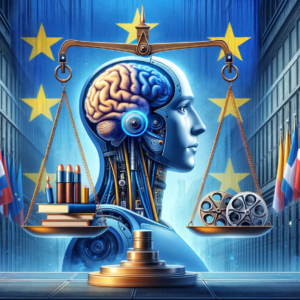Sommaire
A paradigm Shift in AI Governance
The European Union’s Artificial Intelligence Act (EU AI Act) was presented by the Commission in 2021. The European Union’s recent push to regulate artificial intelligence (AI) has sent ripples across the tech world, marking a significant shift in how generative AI models like ChatGPT, Bard, and others will operate.
In a recently negotiated compromise on the European AI Act of December 8, 2023, the focus has sharpened on copyright laws concerning data used in training these AI models.
As the legislation is still under wraps, experts are dissecting the potential impacts based on the EU’s official communications.
Key Obligations for Generative AI Model Creators: Ensuring Transparency and Respect for Copyright
Transparency in Data Usage: The proposed regulation emphasizes the importance of transparency. AI creators must publicly provide a sufficiently detailed summary of the content used for training their algorithms. Though the exact precision of these summaries is yet to be defined, the intent is clear: it aims to identify the rights holders, paving the way for possible compensation negotiations. This move is seen as a win for content creators, including authors, scriptwriters, and media companies, whose work might have been used without direct compensation.
Respect for European Copyright Law: AI enterprises must comply with European copyright laws, a seemingly obvious but vital requirement. This includes adherence to opt-out clauses, allowing rights holders to refuse the use of their content by AI systems. Institutions like the French collective management of author’s rights SACEM have established such clauses.
In depth analysis: Assessing the Impact and Challenges Ahead
Despite the positive outlook, the exact implications remain in the air until the technical meetings conclude. The SACD, among other institutions, expresses cautious optimism but emphasizes the importance of not backtracking on the progress made.
Firstly, while the regulation’s intent to protect copyright holders is commendable, the enforcement and practicality of these rules are somewhat ambiguous. The requirement for a “sufficiently detailed summary” of data used in AI training is vague and could lead to varying interpretations, creating potential loopholes or burdensome compliance processes.
Moreover, the obligation to respect European copyright laws, including opt-out clauses, may be seen as a significant step towards empowering creators. However, this could also impose substantial limitations on the development and scalability of AI technologies, potentially stifling innovation and economic growth. The balance between protecting individual rights and promoting technological advancement seems to be a delicate one, and this regulation might tilt the scales unfavorably for the AI industry.
The tension between transparency and protecting trade secrets is another critical point. Complete transparency of training data could indeed harm businesses, revealing proprietary methods and competitive advantages. The proposed solution of limited disclosure to regulators or trusted entities might mitigate some risks, but it also adds layers of bureaucracy and complexity, possibly slowing down AI development and deployment.
Furthermore, while the regulation is a European initiative, AI is inherently global. The differences in legal and ethical standards across borders might lead to conflicts or compliance challenges for multinational companies. This could inadvertently create a fragmented digital landscape, where AI technologies and their benefits are not evenly distributed.
Lastly, while the regulation aims to protect existing industries and creators from the disruptive impacts of AI, it might also hinder the creative potential and societal benefits that generative AI promises. The cultural and creative sectors could experience a slowdown in innovation if overly restrictive measures are put in place.
The effectiveness and fairness of these measures will depend on their implementation and the continued dialogue among stakeholders. A balanced approach is required to safeguard individual rights and cultural heritage while fostering innovation and global collaboration in the AI domain.
A Nex Era of AI Regulation Begins
As the technical discussions proceed and the final vote nears, stakeholders from all sides are keenly watching, hoping to influence the outcome in their favor. This regulation could set a precedent, not just for Europe, but globally, as countries grapple with the fast-evolving landscape of AI and its widespread implications. The unfolding narrative of the European AI regulation is a testament to the complexities of governing frontier technologies and the need for comprehensive, adaptive, and inclusive policies. The world watches as Europe takes these pioneering steps, setting a precedent for AI governance worldwide.


